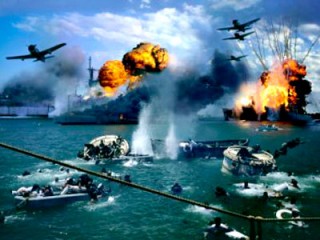The attack on Pearl Harbor (called the Hawaii Operation or Operation Z by the Japanese Imperial General Headquarters, and the Battle of Pearl Harbor by some Americans) was a surprise military strike conducted by the Imperial Japanese Navy against the United States naval base at Pearl Harbor, Hawaii on the morning of December 7, 1941.
The attack was intended as a preventive action in order to keep the U.S. Pacific Fleet from influencing the war that the Empire of Japan was planning in Southeast Asia, against Britain and the Netherlands, as well as the U.S. in the Philippines. The base was attacked by Japanese aircraft (a total of 353, in two waves) launched from six aircraft carriers.
Four U.S. Navy battleships were sunk (two of which were raised and returned to service later in the war) and all of the four other battleships present were damaged. The Japanese also sank or damaged three cruisers, three destroyers, an anti-aircraft training ship[8] and one minelayer. 188 U.S. aircraft were destroyed, 2,402 personnel were killed[9] and 1,282 were wounded. The power station, shipyard, maintenance, and fuel and torpedo storage facilities, as well as the submarine piers and headquarters building (also home of the intelligence section) were not attacked. Japanese losses were light, with 29 aircraft and five midget submarines lost, and 65 servicemen killed or wounded. One Japanese sailor was captured.
 The attack came as a profound shock to the American people and led directly to the United States entry into World War II in both the Pacific and European theaters.
The attack came as a profound shock to the American people and led directly to the United States entry into World War II in both the Pacific and European theaters.
The following day (December 8) the United States declared war on Japan. Domestic support for isolationism, which had been strong, disappeared. Clandestine support of Britain (for example the Neutrality Patrol) was replaced by active alliance and full participation in the European Theater.
Subsequent operations by the U.S., as well as the Axis alliance, prompted Germany and Italy to declare war on the U.S. on December 11, which was reciprocated by the U.S. the same day.
Despite numerous historical precedents for unannounced military action, the lack of any formal warning by Japan, particularly while negotiations were still apparently ongoing, led to President Franklin D. Roosevelt proclaiming December 7, 1941, “a date which will live in infamy”. Recordings of this speech are still played on December 7.
ATTENTION READERS
We See The World From All Sides and Want YOU To Be Fully InformedIn fact, intentional disinformation is a disgraceful scourge in media today. So to assuage any possible errant incorrect information posted herein, we strongly encourage you to seek corroboration from other non-VT sources before forming an educated opinion.
About VT - Policies & Disclosures - Comment Policy



